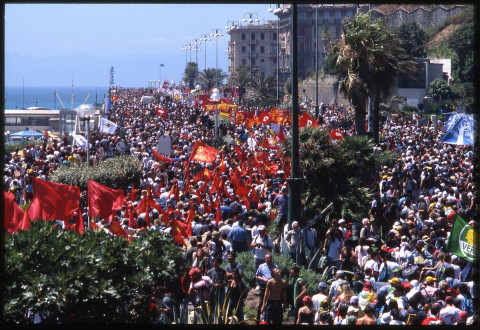From Genoa to today The evolution of global protest
Twenty-three years ago, Genoa's streets thronged with activists fighting for economic, social, and environmental justice. Under the Genoa Social Forum, they laid siege to the G8 leaders. Brutal repression culminated in the tragic death of Carlo Giuliani, marking a watershed in Italian politics. Today, the struggle persists, battling for civil rights and against a right-wing government curtailing dissent.

Michele Ferraris, CC BY-SA 4.0 <https://creativecommons.org/licenses/by-sa/4.0>, via Wikimedia Commons
Twenty three years ago, Arnaldo Cestaro was in Genoa for the G8 summit. He wore a red foulard around his neck and a makeshift buckle hat to protect from the sun. Arnaldo was the oldest victim of ruthless police repression.
SWAT teams stormed the Diaz school, where peaceful demonstrators were sleeping, in the middle of the night. The day before, the streets of the Ligurian city had been the theater of widespread violence and police brutality that cost the life of a young demonstrator, Carlo Giuliani. The police broke Arnaldo's bones, but not his determination. Relentlessly he waged a struggle for truth and justice and won. The European Court of Justice ruled in his favor and condemned the Italian state.
That was a breakthrough that paved the way for a law – albeit of limited reach - against torture. Arnaldo passed away in June 2024, a few days before the annual celebrations of the Genoa Social Forum.
The time is out of joint—O cursèd spite,
That ever I was born to set it right!
In the words of Hamlet, time is implacable, a judge of the past and precursor of the future, it erodes memories, lets words and reflections settle. So, Genoa must be read through a double lens: that of the demands of the movements gathered there to reaffirm the priority of environmental, human and social rights over the laws of liberal globalisation and their right to assemble, contest, dissent, on the one hand and how these were stifled, eroded, maimed on the other, a precursor of new forms of authoritarianism. Time was suspended, space was torn apart, redesigned into forbidden, isolated areas, as if to prefigure the progressive securitisation of public space which in the aftermath of the attack on the
Twin Towers would have progressively restricted and dried up the possibilities of dissent and democratic conflict. Genoa is a scar, an open wound, a tomb, a cradle, a nightmare, a dream, a newborn baby and a grave. “Carlo Giuliani vive” (Carlo Giuliani lives) an unknown hand wrote on the wall that strangles the Haida camp in Bethlehem.
There is a world before Genoa that has a long history, from a black balaclava hiding the face of Subcomandante Marcos and his Zapatista comrades in Chiapas, to Seattle and mobilisations against the G8 in Birmingham and then against the World Bank and IMF in Prague. A crescendo of multitudes, varied as the chromatic diversity of the various blocks that occupied the squares and the streets. Black, Pink, Purple. There is another world after Genoa, that of worldwide massive demonstrations against the war on Iraq, the uprisings, the Arab Spring, Gezi Park, Tahrir Square, Occupy Wall Street or Puerta del Sol, and then Chile, Argentina, Bolivia, Ecuador, with their "destituent" character against the state order, contesting it at its roots.
Geopolitics has progressively been replaced by necropolitics. The one that presupposes the death of its citizens, from repression to the death of migrants at sea. And then the crisis of global governance, and war as its extreme manifestation, with the worsening of the environmental situation and the climate crisis. Necropolitics has then been replaced by biopolitics, that of bodies and ecosystems. Biocide and Necrocapitalism now go hand in hand. War is not only fought between states and peoples but also between humanity and the Earth, a sort of autophagy that undermines the very basis of existence on the planet.
The systemic crisis, which the pandemic further exacerbated, brings everything into relation, the crisis of politics, the climate crisis, the persistence of forms of colonialism, the migrant question and that of patriarchy, the pluriverse, and the urgency of a vision that overcomes anthropocentrism. Boundaries blur, and after the crisis of the World Social Forum model, movements continued to coalesce in other ways, creating transnational networks, thereby introducing new elements that had only been partially perceived until then. Mutual aid, solidarity, self-organisation, horizontal decision-making models, self-production, are the central characteristics of subjects that take up the word again and transform public space. They come and they go, they appear to the surface and then go back underground. Scottish anthropologist Tim Ingold used to say that time is nested; it has no past, no present. Both mingle together, the future is always in the making, opening unexpected possibilities.